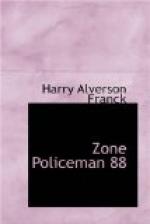CHAPTER IV
One morning early in March “the boss” and I crossed the suspension bridge over the canal. A handcar and six husky negroes awaited us, and we were soon bumping away over temporary spurs through the jungle, to strike at length the “relocation” opposite the giant tree near Bas Obispo that marked the northern limit of our district.
The P.R.R., you will recall, has been operating across the Isthmus since 1855. When the United States took over the Zone in 1904 it built a new double-tracked line of five-foot gauge for nearly the whole forty-seven miles. Much of this, however, runs through territory soon to be covered by Gatun Lake, nearly all the rest of it is on the wrong side of the canal. An almost entirely new line, therefore, is being built through the virgin jungle on the South American side of the canal, which is to be the permanent line and is known in Zone parlance as the “relocation.” This is forty-nine miles in length from Panama to Colon, and is single track only, as freight traffic especially is expected, very naturally, to be lighter after the canal is opened. Already that portion from the Chagres to the Atlantic had been put in use—on February fifteenth, to be exact; and the time was not far off when the section within our district—from Gamboa to Pedro Miguel—would also be in operation.
That portion runs through the wilderness a mile or more back from the canal, through jungled hills so dense with vegetation one could only make one’s way through it with the ubiquitous machete of the native jungle-dweller, except where tiny trails appear that lead to squatters’ thatched huts thrown together of tin, dynamite and dry-goods boxes and jungle reeds in little scattered patches of clearing. Some of these hills have been cut half away for the new line—great generous “cuts,” for to the giant 90-ton steam-shovels a few hundred cubic yards of earth more or less is of slight importance. All else is virtually impenetrable jungle. Travelers by rail across the Isthmus, as no doubt many ships’ passengers will be in the years to come while their steamer is being slowly raised and lowered to and from the eighty-five-foot lake, will see little of the canal,—a glimpse of the Bas Obispo “cut” at Gamboa and little else from the time they leave Gatun till they return to the present line at Pedro Miguel station. But in compensation they will see some wondrous jungle scenery,—a tangled tropical wilderness with great masses of bush flowers of brilliant hues, gigantic ferns, countless palm and banana trees, wonderfully slender arrow-straight trees rising smooth and branchless more than a hundred feet to end in an immense bouquet of brilliant purplish-hue blossoms.
“The boss” barely noticed these things. One quickly grows accustomed to them. Why, Americans who have been down on the Zone for a year don’t know there’s a palm-tree on the Isthmus—or at least they do not remember there were no palm-trees in Keokuk, Iowa, when they left there.




